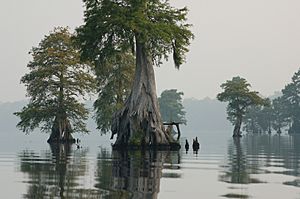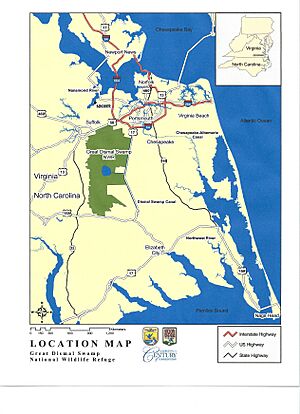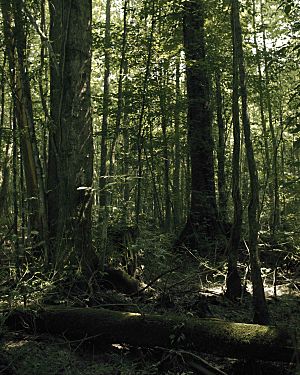Great Dismal Swamp facts for kids
The Great Dismal Swamp is a very large swamp located in the southeastern parts of Virginia and northeastern North Carolina. It sits between the cities of Norfolk, Virginia and Elizabeth City, North Carolina. This huge swamp covers parts of Chesapeake and Suffolk in Virginia, and Gates, Pasquotank, and Camden counties in North Carolina. Originally, the swamp was estimated to be over 1 million acres (about 4,000 square kilometers) in size.
Right in the middle of the swamp is Lake Drummond, a natural lake covering about 3,100 acres (12.5 square kilometers). It's a very round lake and one of only two natural lakes in Virginia. Along the eastern side of the Great Dismal Swamp, you'll find the Dismal Swamp Canal, which was finished in 1805.
Today, much of the swamp is protected. The Great Dismal Swamp National Wildlife Refuge was created in 1973. This happened after the Union Camp Corporation, a company, gave 49,100 acres (199 square kilometers) of land. For centuries, activities like logging had damaged the swamp's natural areas. The refuge was officially set up by the Dismal Swamp Act of 1974. Now, it covers over 112,000 acres (453 square kilometers) of forested wetlands. North Carolina has also protected more parts of the swamp by creating the Dismal Swamp State Park, which covers 22 square miles (57 square kilometers) of forested wetland.
In 1973, a 45,611-acre (185 square kilometer) part of the original swamp was named a National Natural Landmark. This was because of its special mix of geological and ecological features.
Contents
History of the Great Dismal Swamp
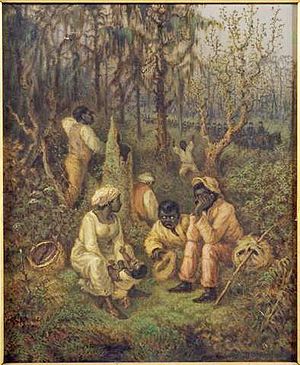
The exact way Lake Drummond was formed isn't fully known. There aren't any clear natural streams that flow into it.
Scientists have found signs that different groups of people have lived in the swamp for about 13,000 years. Around 1650, Native Americans who spoke Algonquian lived in the coastal areas of the swamp. In 1665, William Drummond, who was the first governor of North Carolina, was the first European to find the lake. It was later named after him.
In 1728, William Byrd II explored the swamp while mapping the border between Virginia and North Carolina. He didn't have many good things to say about it and is believed to have named it the "Dismal Swamp." Early settlers didn't understand how important wetlands were for nature. In 1763, George Washington visited the area. He and others started the Dismal Swamp Company. They hoped to drain the swamp for farming, but later focused on cutting down trees, which was more profitable.
Many African-American maroon communities lived in the Great Dismal Swamp during early American history. These were people who had escaped slavery. Digs have shown that these communities existed on islands within the swamp until the Civil War. One maroon named Charlie, who worked secretly in a lumber camp, remembered that whole families lived in the Dismal Swamp. Some of them had never seen a white person and would be very scared if they did. An exhibit called the Underground Railroad Education Pavilion opened on February 24, 2012. It teaches visitors about the people who found freedom in the swamp.
The Dismal Swamp Canal was approved by Virginia in 1787 and by North Carolina in 1790. Building started in 1793 and finished in 1805. This canal, along with a railroad built in 1830, helped people cut down trees and move them out of the swamp. The canal became less used after the Albemarle and Chesapeake Canal was completed in 1858. In 1929, the United States Government bought the Dismal Swamp Canal and started to improve it. Today, it is the oldest working artificial waterway in the country. Like the Albemarle and Chesapeake canals, it is part of the Atlantic Intracoastal Waterway.
Protecting the Swamp
In the mid-1900s, conservation groups across the United States started asking for the Great Dismal Swamp to be protected. They also wanted its wetlands to be restored. People began to understand that wetlands are very important homes for many different birds, animals, plants, and other living things. This area is also on the Atlantic Flyway, a major path for migrating birds.
In 1973, the Union Camp Corporation, a paper company, gave over 49,000 acres (198 square kilometers) of land to The Nature Conservancy. The next year, this land was given to the U.S. Fish and Wildlife Service. Also in 1973, a 45,611-acre (185 square kilometer) part of the swamp was named a National Natural Landmark by the National Park Service. This was because of its special mix of geology and nature.
The Great Dismal Swamp National Wildlife Refuge was officially created by the U.S. Congress through the Dismal Swamp Act of 1974. The refuge now includes almost 107,000 acres (433 square kilometers) of forested wetlands. This includes the 3,100-acre (12.5 square kilometer) Lake Drummond in its center.
The refuge's programs work to bring back and keep the natural biological diversity that once existed in the swamp. This includes managing its water, native plants, and wildlife. Special structures in the ditches help control and save water. Forest management activities, which copy the effects of wildfires, are used to help different kinds of plants grow. Wildlife is managed by making sure they have the right habitats. Sometimes, hunting is allowed to help balance animal populations with the amount of food available.
Animals and Plants of the Swamp
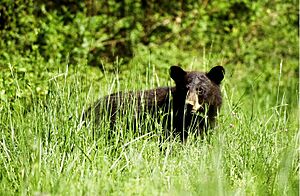
The Great Dismal Swamp is part of the Middle Atlantic coastal forests ecoregion. This means it has a wide variety of plants and animals.
Trees like bald cypress, tupelo, maple, Atlantic white cypress, and pine grow here. These trees provide homes and food for many animals. A survey done from 1973 to 1976 found about 334 different kinds of plants from 100 plant families.
The swamp is home to many mammals, such as black bears, bobcats, otters, and weasels. More than 70 types of reptiles and amphibians also live here. Over 200 bird species can be seen in the swamp throughout the year, with 96 species nesting there.
Lake Drummond Today
Lake Drummond is a popular spot in the swamp today. People enjoy fishing, sightseeing, and boating on the lake. However, camping is not allowed within the refuge.
Images for kids


